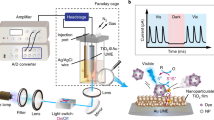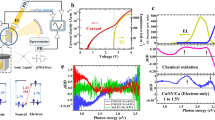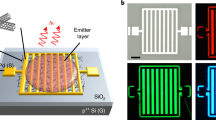Abstract
One of the most widely used techniques to generate light through an efficient electron transfer is called electrochemiluminescence, or electrogenerated chemiluminescence (ECL). ECL mechanisms can be explored via ‘spooling spectroscopy’ in which individual ECL spectra showing emitted light are collected continuously during a potentiodynamic course. The obtained spectra are spooled together and plotted along the applied potential axis; because the potential sweep occurs at a defined rate, this axis is directly proportional to time. Any changes in the emission spectra can be correlated to the corresponding potentials and/or times, leading to a deeper understanding of the mechanism for light generation—information that can be used for efficiently maximizing ECL intensities. The formation of intermediates and excited states can also be tracked, which is crucial to interrogating and drawing electron transfer pathways (i.e., understanding the chemical reaction mechanism). Spooling spectroscopy is not limited to ECL; we also include instructions for the use of related methodologies, such as spooling photoluminescence spectroscopy during an electrolysis procedure, which can be easily set up. The total time required to complete the protocol is ~49 h, from making electrodes and an ECL cell, fabricating light-tight housing, to setting up instruments. Preparing the lab for an individual experiment (making an electrolyte solution of a targeted luminophore, cooling down the CCD camera, calibrating the spectrometer and surveying electrochemistry) takes ~1 h 15 min, and performing the spooling ECL spectroscopy experiment itself requires ~10 min.
This is a preview of subscription content, access via your institution
Access options
Access Nature and 54 other Nature Portfolio journals
Get Nature+, our best-value online-access subscription
$29.99 / 30 days
cancel any time
Subscribe to this journal
Receive 12 print issues and online access
$259.00 per year
only $21.58 per issue
Buy this article
- Purchase on Springer Link
- Instant access to full article PDF
Prices may be subject to local taxes which are calculated during checkout













Similar content being viewed by others
Data availability
The authors declare that the main data supporting the findings of this study are available within the article. A simple sample spooling ECL spectroscopy figure in MATLAB for Ru(bpy)32+ in the presence of 5 mM tri-n-propylamine (TPrA) and its user guide (‘Spooling ECL spectroscopy plot of 0.1 mM Ru(bpy)32+ with 5 mM TPrA using MATLAB’ and ‘Manual to use spooling ECL spectroscopy of Ru(bpy) with TPrA’, respectively) are included in Supplementary Data 1. The spooling ECL spectrum source data in ‘acs’ format and other advanced plotting codes in MATLAB and spreadsheet software Igor are available from the corresponding authors upon request. The data relating to this protocol can be found in this paper and the supporting primary research papers. See the Supplementary Data 1 for data relating to Figs. 9 and 12a. The MATLAB code used in this protocol can be found in the Supplementary Information.
References
Hesari, M. & Ding, Z. Review—electrogenerated chemiluminescence: light years ahead. J. Electrochem. Soc. 163, H3116–H3131 (2016).
Zhou, X. et al. Synthesis, labeling and bioanalytical applications of a tris(2,2′-bipyridyl)ruthenium(II)-based electrochemiluminescence probe. Nat. Protoc. 9, 1146–1159 (2014).
Acharya, D. et al. An ultrasensitive electrogenerated chemiluminescence-based immunoassay for specific detection of Zika virus. Sci. Rep. 6, 32227 (2016).
Hesari, M. & Ding, Z. A grand avenue to Au nanocluster electrochemiluminescence. Acc. Chem. Res. 50, 218–230 (2017).
Liu, Z., Qi, W. & Xu, G. Recent advances in electrochemiluminescence. Chem. Soc. Rev. 44, 3117–3142 (2015).
Kalyuzhny, G., Buda, M., McNeill, J., Barbara, P. & Bard, A. J. Stability of thin-film solid-state electroluminescent devices based on tris(2,2‘-bipyridine)ruthenium(II) complexes. J. Am. Chem. Soc. 125, 6272–6283 (2003).
Swanick, K. N., Hesari, M., Workentin, M. S. & Ding, Z. Interrogating near-infrared electrogenerated chemiluminescence of Au25(SC2H4Ph)18+ clusters. J. Am. Chem. Soc. 134, 15205–15208 (2012).
Swanick, K. N., Ladouceur, S., Zysman-Colman, E. & Ding, Z. Self-enhanced electrochemiluminescence of an iridium(III) complex: mechanistic insight. Angew. Chem. Int. Ed. 51, 11079–11082 (2012).
Hesari, M., Ding, Z. & Workentin, M. S. Electrogenerated chemiluminescence of monodisperse Au144(SC2H4Ph)60 clusters. Organometallics 33, 4888–4892 (2014).
Hesari, M., Workentin, M. S. & Ding, Z. Near-infrared electrochemiluminescence from Au25(SC2H4Ph)18+ clusters co-reacted with tri-n-propylamine. RSC Adv 4, 29559–29562 (2014).
Hesari, M., Workentin, M. S. & Ding, Z. Highly efficient electrogenerated chemiluminescence of Au38 nanoclusters. ACS Nano 8, 8543–8553 (2014).
Hesari, M., Workentin, M. S. & Ding, Z. NIR electrochemiluminescence from Au25– nanoclusters facilitated by highly oxidizing and reducing co-reactant radicals. Chem. Sci. 5, 3814–3822 (2014).
Hesari, M., Workentin, M. S. & Ding, Z. Thermodynamic and kinetic origins of Au250 nanocluster electrochemiluminescence. Chem. Eur. J. 20, 15116–15121 (2014).
Yu, Z. et al. High-resolution shortwave infrared imaging of vascular disorders using gold nanoclusters. ACS Nano 14, 4973–4981 (2020).
Ma, W. et al. Investigating electron-transfer processes using a biomimetic hybrid bilayer membrane system. Nat. Protoc. 8, 439–450 (2013).
Gao, R. et al. Wireless nanopore electrodes for analysis of single entities. Nat. Protoc. 14, 2015–2035 (2019).
Ma, W., Ma, H., Peng, Y. Y., Tian, H. & Long, Y. T. An ultrasensitive photoelectrochemical platform for quantifying photoinduced electron-transfer properties of a single entity. Nat. Protoc. 14, 2672–2690 (2019).
Pei, Q., Yu, G., Zhang, C., Yang, Y. & Heeger, A. J. Polymer light-emitting electrochemical cells. Science 269, 1086–1088 (1995).
Chu, K. et al. Electrogenerated chemiluminescence and electroluminescence of n-doped graphene quantum dots fabricated from an electrochemical exfoliation process in nitrogen-containing electrolytes. Chem. Eur. J. 26, 15892–15900 (2020).
Ding, Z. et al. Electrochemistry and electrogenerated chemiluminescence from silicon nanocrystal quantum dots. Science 296, 1293–1297 (2002).
Wong, J. M. et al. Revealing crystallization induced blue shift emission of a di-boron complex by enhanced photoluminescence and electrochemiluminescence. Angew. Chem. Int. Ed. 59, 17461–17466 (2020).
Hesari, M., Lu, J.-s, Wang, S. & Ding, Z. Efficient electrochemiluminescence of a boron-dipyrromethene (BODIPY) dye. Chem. Commun. 51, 1081–1084 (2015).
Hesari, M. et al. Structural tuning of boron difluoride formazanate electrochemiluminescence mediated by tri-n-propylamine. J. Phys. Chem. C 122, 1258–1266 (2018).
Hesari, M., Barbon, S. M., Staroverov, V. N., Ding, Z. & Gilroy, J. B. Efficient electrochemiluminescence of a readily accessible boron difluoride formazanate dye. Chem. Commun. 51, 3766–3769 (2015).
Hercules, D. M. Chemiluminescence resulting from electrochemically generated species. Science 145, 808–809 (1964).
Chandross, E. A. & Sonntag, F. I. A novel chemiluminescent electron-transfer reaction. J. Am. Chem. Soc. 86, 3179–3180 (1964).
Santhanam, K. S. V. & Bard, A. J. Chemiluminescence of electrogenerated 9,10-diphenylanthracene anion radical. J. Am. Chem. Soc. 87, 139–140 (1965).
Collinson, M. M. & Wightman, R. M. Observation of individual chemical reactions in solution. Science 268, 1883–1885 (1995).
Miao, W. Electrogenerated chemiluminescence and its biorelated applications. Chem. Rev. 108, 2506–2553 (2008).
Richter, M. M. Electrochemiluminescence (ECL). Chem. Rev. 104, 3003–3036 (2004).
Ma, C., Cao, Y., Gou, X. & Zhu, J.-J. Recent progress in electrochemiluminescence sensing and imaging. Anal. Chem. 92, 431–454 (2020).
Qi, H. & Zhang, C. Electrogenerated chemiluminescence biosensing. Anal. Chem. 92, 524–534 (2019).
Voci, S. et al. Surface-confined electrochemiluminescence microscopy of cell membranes. J. Am. Chem. Soc. 140, 14753–14760 (2018).
Ouyang, J. & Bard, A. J. Electrogenerated chemiluminescence: Part IL. Emission from acetonitrile solutions containing no added luminescors. J. Electroanal. Chem. 222, 331–342 (1987).
Shen, M. et al. Electrochemistry and electrogenerated chemiluminescence of a novel donor−acceptor FPHSPFN red fluorophore. J. Phys. Chem. C 114, 9772–9780 (2010).
Guo, W. et al. Potential-resolved multicolor electrochemiluminescence for multiplex immunoassay in a single sample. J. Am. Chem. Soc. 140, 15904–15915 (2018).
He, Y., Yang, L., Zhang, F., Zhang, B. & Zou, G. Tunable electron-injection channels of heterostructured ZnSe@CdTe nanocrystals for surface-chemistry-involved electrochemiluminescence. J. Phy. Chem. Lett. 9, 6089–6095 (2018).
Kang, Y. & Kim, J. Electrochemiluminescence of glutathione-stabilized Au nanoclusters fractionated by gel electrophoresis in water. ChemElectroChem 7, 1092–1096 (2020).
Yang, F. et al. 3D matrix-arranged AuAg nanoclusters as electrochemiluminescence emitters for click chemistry-driven signal switch bioanalysis. Anal. Chem. 92, 2566–2572 (2020).
Hesari, M. et al. Highly efficient dual-color electrochemiluminescence from BODIPY-capped PbS nanocrystals. J. Am. Chem. Soc. 137, 11266–11269 (2015).
Hesari, M. et al. Enhancing electrochemiluminescence of chalcogenide clusters by means of Mn replacement. Electrochimica Acta 210, 79–86 (2016).
Maar, R. R. et al. Aluminum complexes of N2O23– formazanate ligands supported by phosphine oxide donors. Inorg. Chem. 56, 12436–12447 (2017).
Kim, J. M., Jeong, S., Song, J. K. & Kim, J. Near-infrared electrochemiluminescence from orange fluorescent Au nanoclusters in water. Chem. Commun. 54, 2838–2841 (2018).
Shu, J. et al. Potential-resolved multicolor electrochemiluminescence of N-(4-aminobutyl)-n-ethylisoluminol/tetra(4-carboxyphenyl)porphyrin/TiO2 nanoluminophores. Anal. Chem. 89, 12636–12640 (2017).
Guo, W., Ding, H. & Su, B. Electrochemiluminescence of metallated porous organic polymers. J. Electroanal. Chem. 818, 176–180 (2018).
Fu, L., Zhang, B., Fu, K., Gao, X. & Zou, G. Electrochemically lighting up luminophores at similar low triggering potentials with mechanistic insights. Anal. Chem. 92, 6144–6149 (2020).
Bard, A. J. & Faulkner, L. R. Electrochemical Methods: Fundamental and Applications 2nd edn (John Wiley & Sons, 2001).
Doeven, E. H. et al. A potential-controlled switch ON/OFF mechanism for selective excitation in mixed electrochemiluminescent systems. Chem. Sci. 4, 977–982 (2013).
Hogan, C. F., Francis, P. S. & Doven, E. H. Multicolour electrochemiluminescence. in Analytical Electrogenerated Chemiluminescence: From Fundamentals to Bioassays (ed. Sojic, N.) 200–246 (Royal Society of Chemistry, 2020).
Climent, V. & Feliu, J. M. Cyclic voltammetry. in Encyclopedia of Interfacial Chemistry. (ed. Wandelt, K.) 48–74 (Elsevier, 2018).
Acknowledgements
Our special thanks go to J. Vanstone and his team in the Chemistry Electronic Shop who patiently helped us to build many custom parts for our lab, especially for our ECL instrumentation. We also thank the Department of Chemistry and ChemBio Store at The University of Western Ontario for quality support and services. We acknowledge the Natural Sciences and Engineering Research Council of Canada (NSERC, DG RGPIN-2013-201697, RGPIN-2018-06556, SPG STPGP-2016-493924 and several Research Tool and Instruments grants since 2002), Canada Foundation of Innovation/Ontario Innovation Trust (CFI/OIT, 9040), and Premier’s Research Excellence Award (PREA, 2003) for financial support of this research. We thank previous and present members of the Ding group for continuously using and developing the spooling ECL spectroscopy as well as the plotting codes. We appreciate the inspiring advice on the protocol submission from Y. Long.
Author information
Authors and Affiliations
Contributions
M.H. and Z.D. conceived the writing plan and designed the research. M.H. took pictures to illustrate instruments and parts, and performed experiments. M.H. organized and summarized the figures. M.H. and Z.D. wrote the manuscript. Z.D. finalized and submitted the manuscript. All the authors were involved in discussions about the manuscript at all stages.
Corresponding authors
Ethics declarations
Competing interests
The authors declare no competing interests.
Additional information
Peer review information Nature Protocols thanks Joohoon Kim, Jun-Jie Zhu, Gui-Zheng Zou and the other, anonymous, reviewer(s) for their contribution to the peer review of this work.
Publisher’s note Springer Nature remains neutral with regard to jurisdictional claims in published maps and institutional affiliations.
Related links
Key references using this protocol
Hesari, M. et al. J. Am. Chem. Soc. 137, 11266–11269 (2015): https://pubs.acs.org/doi/10.1021/jacs.5b07633
Hesari, M., Workentin, M. S. & Ding, Z. ACS Nano 8, 8543–8553 (2014): https://pubs.acs.org/doi/10.1021/nn503176g
Hesari, M., Workentin, M. S. & Ding, Z. Chem. Sci. 5, 3814–3822 (2014): https://pubs.rsc.org/en/content/articlelanding/2014/SC/C4SC01086H#!divAbstract
Swanick, K. N., Hesari, M., Workentin, M. S. & Ding, Z. J. Am. Chem. Soc. 134, 15205–15208 (2012): https://doi.org/10.1021/ja306047u
Key data used in this protocol
Hesari, M., Workentin, M. S. & Ding, Z. ACS Nano. 8, 8543–8553 (2014): https://pubs.acs.org/doi/10.1021/nn503176g
Hesari, M. et al. J. Am. Chem. Soc. 137, 11266–11269 (2015): https://pubs.acs.org/doi/10.1021/jacs.5b07633
Hesari, M., Workentin, M. S. & Ding, Z. Chem. Sci. 5, 3814–3822 (2014): http://pubs.rsc.org/en/content/articlepdf/2014/sc/c4sc01086h
Extended data
Extended Data Fig. 1 Assembly of a platinum electrode inside a soft glass.
A vacuum tube is attached to one end of the soft glass to assist with Pt rod insertion into the other end.
Extended Data Fig. 2 Schematic assembly of ECL cell-focus lens-PMT.
A photograph of an exemplary ECL cell including WE (Pt disc), CE (Pt coil), RE (Pt coil), sample solution, quartz window, focus lens, and a PMT along with a recorder. Note that the represented distances are not scaled.
Extended Data Fig. 3 An illustration of optical filter position.
a, Top view of the spectrograph port where a filter is placed to block the excitation light source to perform a spooling photoluminescence spectroscopy. b, Side view of the filter and spectrograph port.
Extended Data Fig. 4 Spooling spectroscopy software setup.
A representative of an Andor iDus camera acquisition setup (red box), acquisition mode, exposure time and kinetic series length (pink boxes) are set as spooling, time interval between each spectrum, and total number of spectra. As a common example, experimental parameters related to spooling ECL spectroscopy of 0.1 mM [Ru(bpy)3](PF6)2 (Fig. 9) in the presence of 5 mM tri-n-propylyamine (TPrA) are displayed. The spooling ECL spectra are shown in Fig. 12a. In this exemplary experiment, the applied potential was scanned from 0.0 V to +1.5 V and back to 0.0 V vs. SCE where TPrA was oxidized at ~0.8 V to produce TPrA radicals. At the close potential, Ru(bpy)32+ lost one electron at ~1.1 to Ru(bpy)33+. The total time required for the cycle of potential scan is 30 sec. Thus, one can perform a spooling ECL spectroscopy of Ru(bpy)32+ / TPrA by setting up camera acquisition (red box) and selecting “kinetic” for acquisition mode (first pink box at left). Individual spooling spectra can be collected during 1 s of camera exposure time (second pink box at top left). Usually, the number of accumulations needs to be 1. Finally, “kinetic series length” (third pink box at left) represents total time required for an experiment to complete, which is 30 sec in the present example. The spectrum time interval is defined as the density of the collected spectra in time-space. The shorter the time interval, the higher the number of spectra. To set up a trigger, one needs to set the triggering option to “External Start” which means the camera will start to acquire a spectrum (according the setting) as soon as the external signal has been sent through the coaxial cable from the potentiostat.
Extended Data Fig. 5 Spooling spectroscopy software setup.
Before running a spooling spectroscopy experiment, choose the spooling tab (pink tab) in the acquisition setting (red box) and enable spooling. Next, select “Sif” (shown with arrow) as the file type (first green box at top left). One can choose a file name, e.g., “spool” which will be saved with a “.sif” extension. Lastly, select a path where the recorded file will be saved. Note 1: the last two steps can also be done manually. Note 2: all the recorded spooling files with “.sif” extension should be converted to “.acs” in order to be opened with Igor Pro or MATLAB for plotting.
Extended Data Fig. 6 Exemplary electrode junctions.
Photographs of assembled a, counter electrode, and b, reference electrode inside glass capillaries to protect CE and RE from possible side reactions.
Supplementary information
Supplementary Data 1
Manual to use spooling spectroscopy of Ru(bpy) with TPrA and sample spooling ECL plot using MATLAB software.
Rights and permissions
About this article
Cite this article
Hesari, M., Ding, Z. Spooling electrochemiluminescence spectroscopy: development, applications and beyond. Nat Protoc 16, 2109–2130 (2021). https://doi.org/10.1038/s41596-020-00486-x
Received:
Accepted:
Published:
Issue Date:
DOI: https://doi.org/10.1038/s41596-020-00486-x
This article is cited by
-
Tris(2,2’-bipyridyl)ruthenium (II) complex as a universal reagent for the fabrication of heterogeneous electrochemiluminescence platforms and its recent analytical applications
Analytical and Bioanalytical Chemistry (2023)
Comments
By submitting a comment you agree to abide by our Terms and Community Guidelines. If you find something abusive or that does not comply with our terms or guidelines please flag it as inappropriate.



